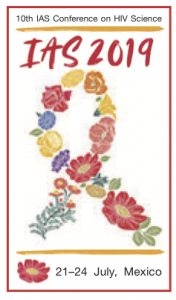Fostemsavir: 96-week follow-up in people with multi-drug resistance
24 July 2019. Related: Conference reports, Antiretrovirals, IAS 10 Mexico City 2019.
 Simon Collins, HIV i-Base
Simon Collins, HIV i-Base
Fostemsavir is a gp-120 attachment inhibitor that has had a long development history as an investigational compound for people with HIV multidrug resistance.
Extended 96-week results from the phase 3 international BRIGHTE study were presented as an oral abstract at IAS 2019 and in a poster. [1, 2]
Because of the difficulty that many potential participants had in constructing background regimens to use with fostemsavir, this study included both a randomised cohort (RC; n=272) for those with some options and an open-label cohort (non-RC: n=99) for people who didn’t meet entry criteria.
Although the primary endpoint for this study was viral reduction after a short 8-day period of virtual monotherapy, and the main secondary endpoint was viral efficacy at week 24, the continued follow-up is important to understand the sustained results.
Median baseline characteristics have been previously reported but in the RC group this included median (range) CD4 and viral load that were approximately 100 cells/mm3 (0 to 1160) and 4.7 log copies/mL (1.6 to 6.9), respectively. Thirty per cent of the group were women.
Baseline characteristics were similar for the open-label group, with the important exception that 80% had no active drugs in the optimised background regimen (OBR) and 20% had only one active drug. Median CD4 count was 41 cells/mm3 in the non-RC group. [3]
Discontinuations during the study occurred in 22% (n=59) in the RC vs 38% (n=38) in the non-RC group, mainly due to lack of efficacy (n=12 vs 6), non-adherence (n=11 vs 6), adverse events (n=7 vs 4), withdrawn consent (n=5 vs 1) and loss to follow up (n=8 vs 1). However, there were 24 deaths (n=9 vs 15), reflecting the very advanced HIV and limited options at baseline. All comparison are RC vs non-RC).
This left 213 (78%) and 61 (62%) in the RC and non-RC arms. At week 96, RC participants had a mean CD4 increase of 205 cells/mm3 with, 60% achieving virologic suppression (an increase of 6% from week 48). Of RC with baseline CD4 < 50, 58% of the RC group increased this to ≥200 cells/mm3. See Table 1.
Overall, 38% participants had a serious adverse event (SAE); 3% were drug related and 7% discontinued due to AE. There were higher rates of severe events in the Non-RC vs RC: SAE (48%/34%), Grade 3-4 AEs (49%/29%), and deaths (16%/4%). Most deaths were related to advanced HIV infection and acute infection.
Results from a substudy of the RC arm was also presented as a poster at IAS 2019. [2]
This reported significant increases in mean CD4 increases for all sub-groups including by age, gender, ethnicity, baseline CD4 and viral load and active ARVs in the background combination. Virological responses were good in all subgroups except those with no other active ARVs in the optimised background combination.
No data have been presented on risk or development of resistance to fostemsavir in participants who continued with detectable viral load on treatment.
Table 1: Viral response rates with fostemsavir by snapshot and observed analysis
| Randomised (n=272) | Non-randomised (n=99) | |||
| Snapshot n (%) | Observed n (%) | Snapshot n (%) | Observed n (%) | |
| Week 24 | 144 (53) | 141/246 (57) | 37 (37) | 37/89 (42) |
| Week 48 | 146 (54) | 145/233 (62) | 38 (38) | 40/83 (48) |
| Week 96 | 163 (60) | 170/214 (79) | 37 (37) | 39/66 (59) |
comment
The long development of this compound were related for manufacturing and formulation issues that has delayed regulatory submission and blocked availability of a named-patient expanded access programme.
Results from the primary endpoint viral suppression at week 24 were presented at EACS in 2017. [3] Several analyses at week 48 were also presented at the Glasgow Conference in 2018. [4, 5]
FDA submission is now expected by the end of 2019 in the US and not until 2020 in the EU. [6]
References
- Lataillade M et al Week 96 safety and efficacy of the novel HIV-1 attachment inhibitor prodrug fostemsavir in heavily treatment-experienced participants infected with multi-drug resistant HIV-1 (BRIGHTE study). 10th IAS Conference on HIV Science (IAS 2019), 21-24 July 2019, Mexico City. Oral abstract MOAB0102.
http://programme.ias2019.org/Abstract/Abstract/3372 - Ackerman P et al. A subgroup analysis of the week 96 efficacy and safety results evaluating fostemsavir in heavily treatment-experienced HIV-1 infected participants in the phase 3 BRIGHTE study: Results from the randomized cohort. 10th IAS Conference on HIV Science (IAS 2019), 21-24 July 2019, Mexico City. Poster abstract MOPEB234.
http://programme.ias2019.org/Abstract/Abstract/4169 - Lataillade M et al. Phase 3 study of fostemsavir in heavily treatment experienced HIV-1 infected subjects: day 8 and week 24 primary efficacy and safety results (BRIGHTE Study, Formerly AI438-047). 16th EACS, 25-27 October 2017. Oral abstract PS8/5.
https://i-base.info/htb/32869 - Aberg J et al. Week 48 safety and efficacy of the HIV-1 attachment inhibitor prodrug fostemsavir in heavily treatment-experienced participants (BRIGHTE study)
. Glasgow HIV Congress 2018, 28 – 31 October 2018. Oral abstract O344A.
https://i-base.info/htb/35310 - Molina J-M et al. Phase III study of fostemsavir in heavily treatment-experienced HIV-1 infected participants: BRIGHTE Week 48 sub- group analysis in randomised cohort participants
.Glasgow HIV Congress 2018, 28 – 31 October 2018. Oral abstract O344B.
https://i-base.info/htb/35310 - Personal communication. See HIV pipeline report 2019. HTB supplement, July 2019.
https://i-base.info/htb/36278

